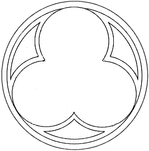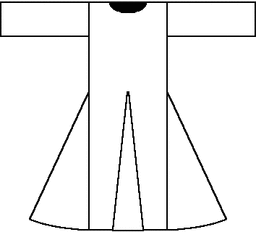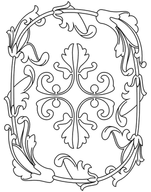Ava represents an early medieval Lady-in-Waiting to Queen Maud of Scotland, wife of King David I.
Medieval Clothing

The materials of Medieval clothing depended greatly on the status of the
wearer. The clothes people wore during the Medieval period were dominated and highly influenced by the Kings and Queens of the country in which they lived. As the feudal system grew, clothing became one way of distinguishing a person's station in life. Another was the type of head-dress a person wore, which immediately conveyed his/her status.
Wool, linen, furs and leather were made into garments. But those materials required a great deal of work before they could be made into clothing. Flax was grown during the summer, harvested and soaked. Soaking time varied, depending on the weather and the water in which it was soaked. Then the linen fibers were washed, brushed several times and finally spun into thread. Spinning took time and women spun almost all the time to produce enough thread to create a garment. After linen was spun, it was woven and then dyed. Dyeing could be done either before or after weaving. If before, threads and warps [the cross threads] could be different color, which gave a two-tone appearance to the fabric. Finally, the linen could be woven into a piece of fabric from which to cut a garment.
Wool had to be sheared from the sheep, the wool washed, then spun like the flax into thread and the thread woven to fabric. Linen and woolen threads could be combined into a fabric, which in later years was called linsey-woolsey. The fabric would not have had a smooth finish or feeling to it but would have slubs or irregular bumps where the thickness of either thread raised the surface of the fabric.
Fur and leather also needed a lot of work. The fat and other remains had to be removed and the pelt tanned. Pelts were an important trade object. Furs and pelts were also products with which one could pay taxes. One valuable fur-bearing animal, the sable which was noted for its smooth glossy fur, even became extinct during the Middle Ages in Finland because of the high demand for fur-trimmed garments. Ermine, marten and fox fur were used to not only trim clothing but also used to make an entire garment.
So what did people wear?
The oldest type of costume was an undergarment known as a smock or chemise [similar to the one pictured below]. Over this came the tunic, usually made of wool. Both women and men used tunic and chemise, but the women's tunic and chemise were longer, her chemise reaching ground and tunic reaching the knee. The tunics often had short sleeves, so they revealed the undergarment. The clothes were loose and these kinds of clothes were used for centuries, varying little.
The male peasants--or serfs--wore breeches probably made of leather or wool and an over-tunic made either of cloth or fur, which was fastened around the waist by a belt. His belt carried a knife and/or tools and a "purse" which was made fashionable by the Crusades for carrying small items. Both men and women wore coarse-woven hose and heavy shoes or boots made with neither a right or left foot but a straight sole. A female serf wore usually wore only one smock-like garment of roughly woven wool or linen. If she as lucky, she may have had a second tunic to wear. Both also wore a cloak of thick woolen material that reached to a mid-calf length and, in cold weather, both donned a close-fitting cap of wool, felt or skin called a coif or a hood with a dangling end called liripipe. Women covered their hair with a veil and protected their necks with a wimple. Gloves were worn only for their practical use to protect the hands.
The nobility and upper classes were the only ones who could afford to dress fashionably. The styles of women's clothing still bore resemblance to Classical Greek and Roman clothing in the early Medieval years, but, as time passed, a woman's clothing became more closely fitted so as to display her figure. A Medieval noble woman wore a chemise of finely woven linen and a tunic with or without sleeves. It is usually the colorful tunic that you notice when looking at paintings or tapestries of that era. A married woman wore a drapery or veil over her hair, while unmarried ladies wore their hair loose or confined in one or two braids. Where the peasants wore heavy shoes or boots--or went bare-foot--the noble woman had a choice of footwear: soft slippers and cloth shoes for indoor wear and sturdier leather shoes for outdoors.
Eventually, laws were enacted--especially in England--to reign in the nobles' excessive spending on clothing, jewelry, furniture, food and beverages. These laws were called sumptuary laws and were designed to control behavior and to ensure that a specific class structure was maintained.

wearer. The clothes people wore during the Medieval period were dominated and highly influenced by the Kings and Queens of the country in which they lived. As the feudal system grew, clothing became one way of distinguishing a person's station in life. Another was the type of head-dress a person wore, which immediately conveyed his/her status.
Wool, linen, furs and leather were made into garments. But those materials required a great deal of work before they could be made into clothing. Flax was grown during the summer, harvested and soaked. Soaking time varied, depending on the weather and the water in which it was soaked. Then the linen fibers were washed, brushed several times and finally spun into thread. Spinning took time and women spun almost all the time to produce enough thread to create a garment. After linen was spun, it was woven and then dyed. Dyeing could be done either before or after weaving. If before, threads and warps [the cross threads] could be different color, which gave a two-tone appearance to the fabric. Finally, the linen could be woven into a piece of fabric from which to cut a garment.
Wool had to be sheared from the sheep, the wool washed, then spun like the flax into thread and the thread woven to fabric. Linen and woolen threads could be combined into a fabric, which in later years was called linsey-woolsey. The fabric would not have had a smooth finish or feeling to it but would have slubs or irregular bumps where the thickness of either thread raised the surface of the fabric.
Fur and leather also needed a lot of work. The fat and other remains had to be removed and the pelt tanned. Pelts were an important trade object. Furs and pelts were also products with which one could pay taxes. One valuable fur-bearing animal, the sable which was noted for its smooth glossy fur, even became extinct during the Middle Ages in Finland because of the high demand for fur-trimmed garments. Ermine, marten and fox fur were used to not only trim clothing but also used to make an entire garment.
So what did people wear?
The oldest type of costume was an undergarment known as a smock or chemise [similar to the one pictured below]. Over this came the tunic, usually made of wool. Both women and men used tunic and chemise, but the women's tunic and chemise were longer, her chemise reaching ground and tunic reaching the knee. The tunics often had short sleeves, so they revealed the undergarment. The clothes were loose and these kinds of clothes were used for centuries, varying little.
 | ||
| Peasants at work. (Image courtesy of Museums at Redcar and Cleveland http://www.redcar-cleveland.gov.uk) |
The male peasants--or serfs--wore breeches probably made of leather or wool and an over-tunic made either of cloth or fur, which was fastened around the waist by a belt. His belt carried a knife and/or tools and a "purse" which was made fashionable by the Crusades for carrying small items. Both men and women wore coarse-woven hose and heavy shoes or boots made with neither a right or left foot but a straight sole. A female serf wore usually wore only one smock-like garment of roughly woven wool or linen. If she as lucky, she may have had a second tunic to wear. Both also wore a cloak of thick woolen material that reached to a mid-calf length and, in cold weather, both donned a close-fitting cap of wool, felt or skin called a coif or a hood with a dangling end called liripipe. Women covered their hair with a veil and protected their necks with a wimple. Gloves were worn only for their practical use to protect the hands.
 |
| Noble woman spinning |
 |
| Medieval slipper with detail of lacing holes |
 |
| Medieval shoe with instep buckle |
[If you would like to know more detailed information about Medieval clothing and other facets of Medieval life, please visit:
Please be aware that the link takes you away from this site.Ava's Smock

Ava would have worn a smock as her undergarment beneath any outer gown. At ankle-length, her smock was made of linen, a natural fiber cloth made from the flax plant. Cotton was not imported in considerable quantity for making clothing until 1430 in England. [The Draper's Dictionary, quoted by C. Willet and Phillis Cunnington, The History of Underclothes, p. 22. (New York: Dover Publications, 1992.)]
A smock was also known as a chemise in French, a word introduced by the Normans, and a camicia in Italian. Whatever it was called, the smock was generally the only undergarment worn throughout much of the Middle Ages. Wearing drawers--an idea stolen from men--was unheard of until the late 1400's when the practice gradually spread from Italy to Spain and France and then to England by the mid-1600's. [Cunnington, History of Underclothes, p. 65.]
A smock was also known as a chemise in French, a word introduced by the Normans, and a camicia in Italian. Whatever it was called, the smock was generally the only undergarment worn throughout much of the Middle Ages. Wearing drawers--an idea stolen from men--was unheard of until the late 1400's when the practice gradually spread from Italy to Spain and France and then to England by the mid-1600's. [Cunnington, History of Underclothes, p. 65.]
[Curious? To learn more about the subject of drawers, please visit:
http://realmofvenus.renaissanceitaly.net/library/drawers.htm.] Please be aware that the link takes you away from this site.
Ava's Gowns
Section Under Construction.http://realmofvenus.renaissanceitaly.net/library/drawers.htm.] Please be aware that the link takes you away from this site.
Ava's Gowns
Ava's Accessories

Section Under Construction.
If you would like to know more about Ava, please click here.

